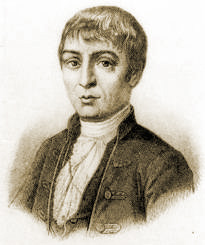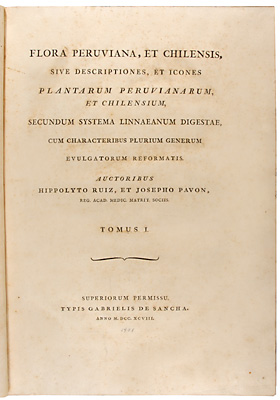Hipólito Ruiz López facts for kids
Quick facts for kids
Hipólito Ruiz López
|
|
|---|---|
 |
|
| Born | August 8, 1754 |
| Died | 1816 (aged 61–62) |
| Nationality | Spanish |
| Scientific career | |
| Fields | Botany |
Hipólito Ruiz López (born August 8, 1754, in Belorado, Spain – died 1816, in Madrid) was a famous Spanish botanist. He is best known for his important work studying plants in Peru and Chile. He went on a big trip there from 1777 to 1788, ordered by King Charles III.
During King Charles III's rule, three major science trips were sent to the "New World" (the Americas). Hipólito Ruiz and José Antonio Pavón Jiménez were the main plant experts for the first of these trips. Their mission was to explore Peru and Chile.
Contents
A Young Scientist's Journey
Hipólito Ruiz López started learning Latin when he was young, taught by his uncle who was a priest. At 14, he moved to Madrid to study many subjects. These included logic, physics, chemistry, and how medicines work (pharmacology).
He also studied plants at the Migas Calientes Botanical Gardens. This garden is now known as the Real Jardín Botánico de Madrid. His teachers were well-known botanists like Casimiro Gómez Ortega and Antonio Palau Verdera.
Even before he finished his studies, Hipólito Ruiz was chosen to lead a big plant-finding trip. He was named the head botanist for the expedition. Other important people on the team included Joseph Dombey, a French doctor, and José Antonio Pavón y Jimenez, who studied medicines. Two artists, Joseph Bonete and Isidro Gálvez, also joined to draw the plants.
An Amazing Trip to South America
The expedition team set sail from Cádiz, Spain, in 1777. They arrived in Lima, Peru, in April 1778. For ten years (from 1778 to 1788), they explored different parts of Peru and Chile. They collected many plant samples, called specimens.
They gathered about 3,000 plant specimens. They also made 2,500 detailed drawings of the plants as they looked in real life. When they returned to Spain, they brought back many living plants too.
One interesting discovery was a plant called Buddleja incana, also known as quisoar. They found that boiling its young shoots made a remedy for colds. If mixed with urine, it could even help with toothaches!
Discoveries and Important Books
Most of the collections arrived safely in Cádiz in 1788. They were stored at the Real Jardín Botánico de Madrid and the Museum of Natural History. The team had found about 150 new types of plants (genera) and 500 new plant species. Many of these still have the names given to them by Ruiz and Pavón.
Sadly, part of their collection was lost. A ship carrying 53 crates sank off the coast of Portugal. These crates held 800 drawings, dried plants, seeds, and minerals.
After returning to Spain, Ruiz finished his studies in pharmacology and graduated in 1790. He became a member of the Royal Academy of Medicine in 1794. He published many articles in their scientific papers.
He and Pavón worked together to publish a huge book called Flora Peruviana et Chilensis. This book had ten volumes and was filled with beautiful pictures of the plants they found. The first four volumes came out between 1798 and 1802. The rest were published after Ruiz passed away.
Before he died, Ruiz also wrote a book about the cinchona tree, called Quinología o tratado del árbol de la quina. This book was very popular and was quickly translated into Italian, German, and English. Even the famous explorer Alexander von Humboldt mentioned Ruiz's work in his own book about cinchona.
Learning from Nature and People
The journals Ruiz kept during his South American trip are amazing. They show how much he knew about plants and nature. He also learned about how local people used plants (ethnobotany).
The Spanish King was especially interested in plants that could be used as medicine. One very important plant was the Chinchona tree. This tree is the source of quinine, a medicine used to treat malaria.
Besides describing and drawing plants and animals, Ruiz also wrote about the rocks and weather of the areas he visited. He even included details about the lives of the local Indigenous people and the colonists.
Hipólito Ruiz López died in 1816 in Madrid.
Plants Named by Ruiz and Pavón
Many types of plants (genera) were first named by Ruiz and Pavón, or have species named by them. Here are some examples:
- Clarisia (1794)
- Lapageria (1802)
- Amaryllis (1802)
- Cordia (1794)
- Baccharis (1794)
- Brunellia (1794)
- Fabiana (1794)
- Puya (1794)
- Stipa (1794)
- Calandrinia (1794)
- Vestia (1794)
- Crassula (1794)
- Krameria (1794)
- Datura (1794)
- Clethra (1794)
- Graffenrieda (1794)
- Escallonia (1794)
- Miconia (1794)
- Cyperus (1794)
- Piper (1794)
- Wigandia (1794)
- Nama (1794)
- Jaltomata (1794)
- Jarava (1794)
- Heteranthera (1794)
- Collomia (1794)
- Acaena (1794)
- Verbena (1794)
- Cinchona (1794)
- Triglochin (1794)
- Fortunatia (1794)
- Lardizabala (1794)
- Myrospermum (1794)
- Alstromeria (1794)
- Montiopsis (1794)
- Renealmia (1794)
- Tessaria (1794)
- Ipomoea (1794)
- Xyris (1794)
- Aloysia (1794)
- Tillandsia (1794)
- Spermacoce (1794)
- Sphaeradenia (1794)
- Salpiglossis (1794)
- Schizanthus (1794)
- Pouteria (1794)
- Fuchsia (1794)
- Polylepis (1794)
- Leonia (1794)
- Psammisia (1794)
- Thibaudia (1794)
- Acunna (1794)
- Richardella (1794)
- Iriartea (1794)
- Phytelephas (1794)
- Capsicum (1794)
- Chondodendron (1794)
- Tropaeolum (1794)
- Sessea (1794)
- Geophila (1794)
- Psychotria (1794)
- Canna (1794)
Famous Orchids They Found
- Gongora (1794)
- Sobralia (1798)
- Lycaste (1798)
- Epidendrum (1794)
- Bletia (1794)
- Masdevallia (1794)
- Maxillaria (1794)
- Anguloa (1794)
- Cattleya (1794)
- Fernandezia (1794)
- Rodriguezia (1794)
Other Exciting Expeditions
King Charles III sent four major plant-finding trips to the Spanish colonies. These were:
- The trip by Ruiz and Pavón to Peru and Chile (1777–1788).
- José Celestino Mutis's trip to New Granada (1783–1808).
- Juan de Cuéllar's trip to the Philippines (1786–1797).
- Martín Sessé y Lacasta's trip to New Spain (1787–1803).
Honored in the Plant World
Hipólito Ruiz López has been honored by having two plant groups (genera) named after him. In 1786, a botanist named Cav. named the genus Ruizia after him. These are flowering plants found on the island of Réunion. Later, in 1936, another botanist named R.E.Fr. named Ruizodendron after him. This is a type of flowering plant from South America.
See also
 In Spanish: Hipólito Ruiz López para niños
In Spanish: Hipólito Ruiz López para niños


